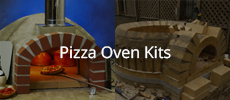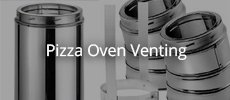Re: 40" Indoor Pompeii in NNY
Thanks David for your thoughts. I will be happy if I can just leave as is.. looking forward to getting done cutting bricks! I figure most people use the bricks for the floor at 2 1/4" thick and I can't recall anyone mentioning a brick cracking there. There will be quite a bit of heat on those 4 bricks though!
Announcement
Collapse
No announcement yet.
40" Indoor Pompeii in NNY
Collapse
X
-
Re: 40" Indoor Pompeii in NNY
Just an update on the top of the flue area. Got the 4 pieces in finally. So tomorrow I can adjust the hole slightly as it got a little out of round with tweaking the bricks while mortaring them in. The side to side dimension is a tad smaller than it should be and I don't want to restrict the air flow in any way shape or form. Once that is done I can cut the outside arch bricks to wedges and build the outside arch!1 Photo
Leave a comment:
-
Re: 40" Indoor Pompeii in NNY
It looks plenty thick enough to me.
Leave a comment:
-
Re: 40" Indoor Pompeii in NNY
Anyone have an opinion on whether or not the 2 1/4" thickness of the brick across the top of the flue is thick enough? I designed it with the angled sides so it would support itself even if it cracked at some point. I plan on covering the top completely with 1/2" thick insulation on the top side, under the metal plate. That will stop any smoke coming up through if it does crack. The question is.. should I go thicker on the brick layer?
Leave a comment:
-
Re: 40" Indoor Pompeii in NNY
Just a small update as I am probably the slowest amateur mason in the world..
Still working on the transition area but finally starting to put in the bricks at the top that will have the transition plate attached!
Three shots of 1 of the 4 pieces. On the backside of the transition area I am going to put in some AlSi board cut to fit between the dome and transition bricks and cement it in with high temperature caulk, like Gulf did with his build. I ordered 2 tubes of JACO firestop which is rated to 3000 F. That should do the trick in making sure no smoke sneaks by the insulation between the dome and transition area.3 Photos
Leave a comment:
-
Re: 40" Indoor Pompeii in NNY
Just a small update with a couple photos. Making progress with the entry way. I think it has finally come together in my mind how I want to construct it. Now just hoping that it performs the way I think it will once in operation!
Photo close up of the notched brick next to the dome with the insulation in place.
Photo which shows mostly one side of the entry about half way done. The line on the dome arch will be the inside face of the remaining entry/flue bricks. The outer arch bricks will extend to the wood form, against the outward face of the flue bricks. This will make a bit of a pocket between the two arches to help collect smoke and keep it from rolling right out the bottom of the outer arch.2 Photos
Leave a comment:
-
Re: 40" Indoor Pompeii in NNY
Hmm good point KB on the added protection for the brick and hearth edges. I think (crossing fingers) that I will be ok without. I have a pretty small gap and leveled everything well. My transition area is also quite short so it won't be too hard to put things down beyond the marble/brick interface. I want to avoid dragging things across the marble as much as possible since it is pretty soft and will scratch very easily as is.
Gulf - smoke escaping from around the seam between the dome arch and the transition bricks is a concern. I have a pretty good seal already with the 1/2" thick insulation where I notched the brick up against the dome. I can't say for sure it will be perfect though. I was thinking of maybe doing something like you did with the ceramic board cut to fit over that joint on the outside, and then securing in place on both sides. I was considering using the Jaco Firestop 3000deg caulking to seal between the brick and the board. I think that would give a good seal and offer a little flexibility to the union.
Leave a comment:
-
Re: 40" Indoor Pompeii in NNY
It is the air between the strands that makes glass a better insulator. If it melts and forms a solid then it will perform poorly. But, the Rutland Black is rated to 1000 F. Ceramic Fiber rope would be better, if you can get it. The air gap will work just fine for impeding the heat transfer. But, I think that you need to consider one other possibility. All the smoke must go up your flu, since you have an inside build. You don't want smoke escaping from that joint into your home. Seal it to where there is no possible way for that to happen. Or, ( if it were me) I would just forget about a heatbreak there.Originally posted by Tonyp View PostI decided to just leave the small air gap as is. I figured the fiberglass compressed against the dome and floor bricks in that small gap, if anything would increase heat transfer between the two bricks. Last time I checked glass wasn't a very good insulator.
Just Sayin'
Leave a comment:
-
Re: 40" Indoor Pompeii in NNY
Tony,
Nice looking piece of stone, looking good. I'm sure you would hate to see that piece of stone all chipped up after some oven use. Something that I did on my build you may want to consider on yours. Attached in a picture of oven landing. The stainless tubing serves as a heat break. Added benefit and glad it worked out that way, is protecting the hearth counter and brick edges from chipping and breaking. I would have some pretty severe chips at this point if the smooth raised edge of the stainless was not there. Cast iron pots and grill grates griddle etc... easily slide over the rounded edge. I'm sure I would have chipped something by now if they weren't there. 2 Photos
2 Photos
Leave a comment:
-
Re: 40" Indoor Pompeii in NNY
I decided to just leave the small air gap as is. I figured the fiberglass compressed against the dome and floor bricks in that small gap, if anything would increase heat transfer between the two bricks. Last time I checked glass wasn't a very good insulator.
Leave a comment:
-
Re: 40" Indoor Pompeii in NNY
Landing and entrance area is starting to come together. The row of bricks and marble are all set. Started cutting some of the bricks for the entry and checking layout. The two wood blocks are the location for the ends of the outer arch.
Still unsure if I should do anything with that 1/2" wide section of brick that is about 1/8" from the dome arch. Leave it as just an air gap or put something in there.. I picked up some of the Rutland graphite/fiberglass rope to play around with but not sure if that would increase or decrease the heat flow from the arch dome across to the entry bricks. I could also put in a little strip of ceramic board or microsil and just leave it shy of the brick face by an 1/8" or so.1 Photo
Leave a comment:
-
Re: 40" Indoor Pompeii in NNY
Preparing the landing area for the row of brick and marble slab. The grey insulation is 1/2" thick microsil from Zircar Ceramics. I am going put a 3/8" notch on the underside of the brick so there will be roughly a 1/16"-1/8" wide x 1/2" deep air gap between the oven floor and the row of bricks in the landing area. I was thinking to just let that gap fill with ash. Does that sound reasonable?1 Photo
Leave a comment:
-
Re: 40" Indoor Pompeii in NNY
oh in case you are wondering, I used the skil saw and dry cutting blade to rough cut out the initial piece. Which made a huge cloud of marble dust in the basement...
Leave a comment:
-
Re: 40" Indoor Pompeii in NNY
Moving on to the next phase in construction, the landing area..
Years ago my wife procured a number of 4 x 8 slabs of marble from the local hospital when they were remodeling and removing all these old bathroom stalls made of marble. How she convinced the construction crew to carry these things down and load them into a pickup is beyond me.. they must way about 400 pounds. Most are 3/4" thick but there were some 1 1/4 also. We have used the marble around the house for various projects from windowsills and an island top in the new kitchen. She wants use some of the thicker stone as part of the oven landing and the thinner stone for a vertical face to tie it together with the other marble stuff in the kitchen...oh how I love working with huge slabs of marble..
I sketched out the design and layout for the landing. One row of firebrick across the oven opening followed by a slab of marble which would extend out beyond the outer arch. So how to tackle cutting to shape a 1 1/4" thick 36" long 15" wide chunk of marble. I have a dry cutting diamond blade for the skil saw a 10" dry cutting blade I could put on the table saw and the 10" HF wet saw. I was preferring the wet saw as it makes a pretty good cut. After mulling over the situation for a few days I came up with a jig to hold the slab and allow me to maneuver the stone around and use the sliding table on the HF saw..
Behold the .. uh slab jig!
and with the marble for cutting..
The long side cut was longer than the travel distance of the HF table so I would have to cut about halfway then pull the table back and slide the slab forward to make the full cut.2 Photos
Leave a comment:
-
Re: 40" Indoor Pompeii in NNY
So I am mostly caught up with the current build status. I thought I would post a few pictures of the brick jig etc. I removed the rubber thingy on the table of the HF saw and sanded the aluminum down to level it a bit. There are holes through the table which I found to be handy to screw jigs up from the bottom to hold them to the table.
Brick cutting jig made from 2 x 8 pressure treated pine. The bolt for angle adjustment goes up through the bottom. There is a t nut in between as well as one on top (visible) to set the angle. It was also easy to adjust the oak strips for the other angle as needed.1 Photo
Leave a comment:





Leave a comment: